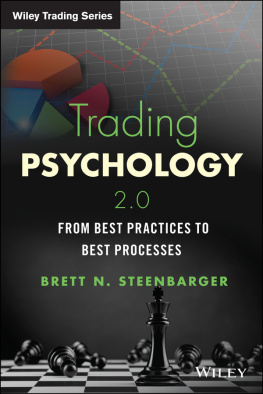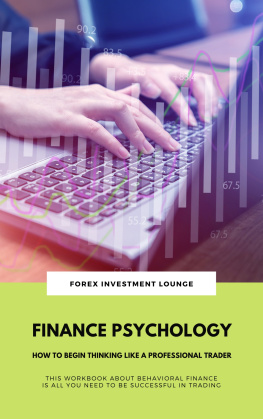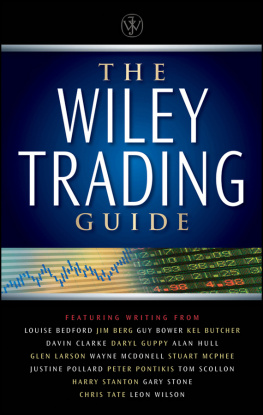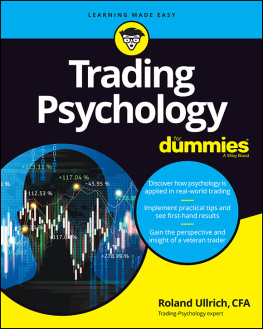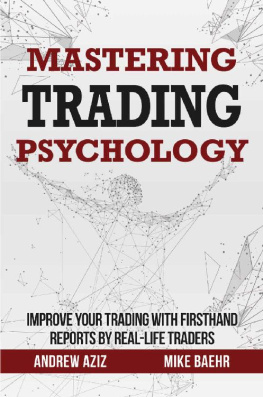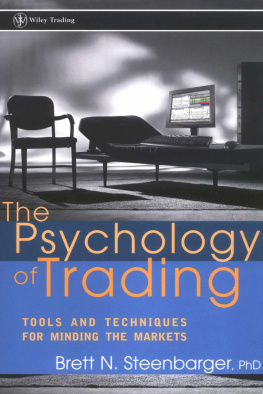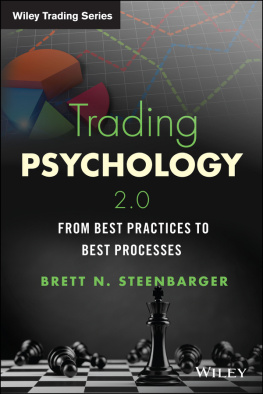
Founded in 1807, John Wiley & Sons is the oldest independent publishing company in the United States. With offices in North America, Europe, Australia and Asia, Wiley is globally committed to developing and marketing print and electronic products and services for our customers' professional and personal knowledge and understanding.
The Wiley Trading series features books by traders who have survived the market's ever changing temperament and have prospered-some by reinventing systems, others by getting back to basics. Whether a novice trader, professional or somewhere in-between, these books will provide the advice and strategies needed to prosper today and well into the future.
For more on this series, visit our website at www.WileyTrading.com.
Copyright 2015 by Brett Steenbarger. All rights reserved.
Published by John Wiley & Sons, Inc., Hoboken, New Jersey.
Published simultaneously in Canada.
No part of this publication may be reproduced, stored in a retrieval system, or transmitted in any form or by any means, electronic, mechanical, photocopying, recording, scanning, or otherwise, except as permitted under Section 107 or 108 of the 1976 United States Copyright Act, without either the prior written permission of the Publisher, or authorization through payment of the appropriate per-copy fee to the Copyright Clearance Center, Inc., 222 Rosewood Drive, Danvers, MA 01923, (978) 750-8400, fax (978) 646-8600, or on the Web at www.copyright.com. Requests to the Publisher for permission should be addressed to the Permissions Department, John Wiley & Sons, Inc., 111 River Street, Hoboken, NJ 07030, (201) 748-6011, fax (201) 748-6008, or online at http://www.wiley.com/go/permissions.
Limit of Liability/Disclaimer of Warranty: While the publisher and author have used their best efforts in preparing this book, they make no representations or warranties with respect to the accuracy or completeness of the contents of this book and specifically disclaim any implied warranties of merchantability or fitness for a particular purpose. No warranty may be created or extended by sales representatives or written sales materials. The advice and strategies contained herein may not be suitable for your situation. You should consult with a professional where appropriate. Neither the publisher nor author shall be liable for any loss of profit or any other commercial damages, including but not limited to special, incidental, consequential, or other damages.
For general information on our other products and services or for technical support, please contact our Customer Care Department within the United States at (800) 762-2974, outside the United States at (317) 572-3993 or fax (317) 572-4002.
Wiley publishes in a variety of print and electronic formats and by print-on-demand. Some material included with standard print versions of this book may not be included in e-books or in print-on-demand. If this book refers to media such as a CD or DVD that is not included in the version you purchased, you may download this material at http://booksupport.wiley.com. For more information about Wiley products, visit www.wiley.com.
Library of Congress Cataloging-in-Publication Data
Steenbarger, Brett N.
Trading psychology 2.0 : from best practices to best processes / Brett N Steenbarger, Ph.D.
pages cm.(Wiley trading series)
Includes index.
ISBN 978-1-118-93681-8 (hardback)ISBN 978-1-118-93683-2 (ePDF)
ISBN 978-1-118-93682-5 (epub)
1. StocksPsychological aspects. 2. SpeculationPsychological aspects.
3. InvestmentsPsychological aspects. I. Title.
HG6041.S762 2015
332.6401'9dc23
2015016663
Cover Design: Wiley
Cover Images: Business growth graph iStock.com/Violka08; Black Chess King and lying
Pawns on board iStock.com/Dominik Pabis
Epigraph
If you don't have time to do it right, when will you have time to do it over?
John Wooden
Preface
Successful efforts to master markets lead us down paths of self-mastery. This book is one guide to those paths.
Market participants have traditionally defined self-mastery as disciplinecontrolling the emotions that all too often distort information processing and trigger impulsive behavior. To be sure, discipline is required for any great undertaking, whether it is pursuing an Olympic medal, a business startup, or a medical breakthrough. But discipline, while necessary for success, is never sufficient. Discipline does not substitute for skill, talent, and insight. Strict, disciplined adherence to mediocre plans can only lock in mediocre results. If it were otherwise, there would be no losing automated trading systems.
I've followed and traded markets since the late 1970s. During the past decade, I have served as a full-time performance coach at two trading firmsKingstree Trading in Chicago and Tudor Investment Corp. in Greenwich, Connecticutand worked with many other trading organizations on a consultative basis. Through the TraderFeed blog and three prior trading books, I've had the honor of interacting with thousands of traders around the world. If there's one thing this whirlwind of experience has taught me, it's that there is far more to market mastery than controlling emotions and impulses. Sustained success requires the cultivation of a host of positive performance elements: creativity, productivity, adaptation to change, and psychological well-being. The good news is that recent research in psychology and related fields has profoundly deepened our understanding of these contributors to human performance. The bad news is that most of us in the money management world, immersed in the day-to-day challenges of keeping up with news flows and market movements, have little opportunity to sift through and apply this knowledge. As a consequence, we tend to work hard, but not smart. From the organization of our daily routines to our reviews of performance, we rarely optimize learning, independent thought, and productivity.
The unfortunate tendency to substitute quantity of effort for quality ensures that we will face a yawning gap between our real and ideal selves: between who we are and who we're capable of becoming. Trading Psychology 2.0 seeks to bridge that gap by breaking trading success down to four essential processes. In the coming pages, you will learn a simple ABCD:
- A How to dynamically Adapt to changing market conditions
- B How to identify and Build on your distinctive trading strengths
- C How to Cultivate creative processes and generate fresh market perspectives
- D How to Develop best practices that help you sustain productivity and effectiveness in your work routines
Most of all, this book is about taking best practicesthe ingredients of your trading successand weaving them into best processes. The goal is not to change you but to help you more consistently tap into the drivers of your success.
In hindsight, it's not difficult to see that Trading Psychology 2.0 is a natural extension of my previous books. The first of these, The Psychology of Trading, focused on the emotional problems faced by traders and how these mirror common life challenges. It introduced a solution-focused framework to trading: identifying the patterns that underlie our success and becoming more consistent in enacting those. My second book, Enhancing Trader Performance, adopted a developmental view of trading success, emphasizing expertise development as an ongoing process of deliberate practice that matches skills, talents, and challenges. An important implication of that work was that there are many forms of trading, each requiring unique skills and learning processes. I continue to find that many of the emotional problems faced by developing traders are the result of bolting generic learning processes onto very specific performance domains, creating frustration and suboptimal performance. Finally, my most recent text,
Next page
